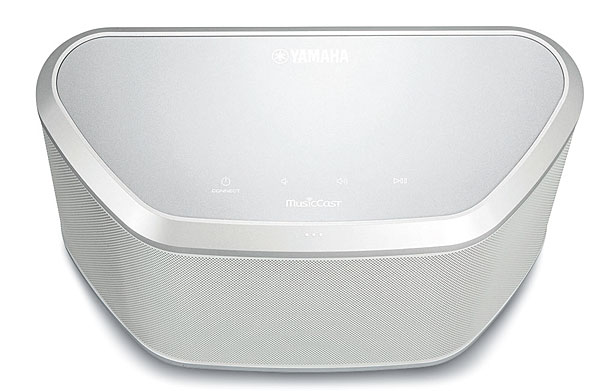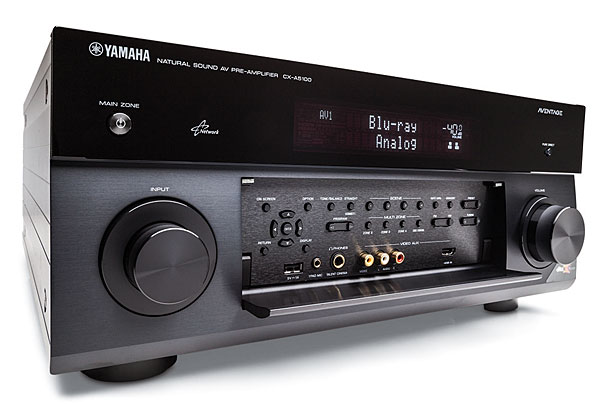Yamaha Aventage RX-A2050 A/V Receiver Review Page 2
Rising at Nine
Not to spoil the ending, but in day-to-day use the RX-A2050 mates a great-sounding amp with just-average room correction, making this close to but not quite a five-star product. I did most of my cinematic listening with room correction and much of my music listening without it. The amp’s personality combines tight bass with a communicative and upfront midrange. It’s a dispassionate and largely neutral sound; fed warm material, however, the receiver can adopt that character. The big question is whether this receiver has enough oomph to power all nine channels in movies with aggressive all-channel effects. The answer in my room is yes. I never felt cheated of dynamic nourishment with the Paradigms, which are of average sensitivity, nor with the Klipsches, which are of higher sensitivity. Depending on the sensitivity of your speakers and the size of your room, your mileage may vary.
Terminator Genisys (Dolby Atmos utilizing Dolby TrueHD) was, as I exclaimed in my notes, “mastered super loud!” I achieved cruising altitude at –28 on the volume scale, though my preferred settings for other movies edged up the scale a few decibels. I played movies in the Straight mode, which included YPAO room correction but avoided other proprietary Yamaha processing. Occasionally, I dipped into the Pure Direct mode, which delivered the same 9.1 channels but without YPAO; that warmed up the tonal balance. The most notable recurring Atmos height effect was the wide-spectrum synthesized whirligig of the time machine, which charged those scenes with excitement. This loud effect, combined with the other elements in the scene, was the receiver’s biggest dynamic challenge, and it was handily met.
The original Dolby Atmos Demonstration Disc showed that the Yamaha and the Klipsch Atmos speakers reinforce each other wonderfully. In Enrique Iglesias’ “Bailando,” the subtle choral oh-oh-ohs—which are less than half as loud as the track’s overall level—floated ethereally but unmistakably in the 5.1.4 bubble. When I switched to the Pure Direct mode (without YPAO room correction), it enlarged but softened the soundfield, slightly reduced the elevation of height effects, and thickened bass by not correcting the room’s standing wave.
 I used the first few scenes of The Loft (DTS-HD Master Audio), a mordant whodunit, to see how Dolby Surround would create derived height channels from a 5.1-channel soundtrack. It emphasized the feeling of rain (of course), flattered the soundtrack’s orchestral strings with synthetic air, and generally lightened the tone. This is as much a commentary on Dolby Surround and the Klipsch elevation speakers as on the receiver—though the receiver’s nine amp channels once again held up their end. The receiver did a faultless job with dialogue reproduction and generated an involving traditional 5.1 soundfield when called upon to do so.
I used the first few scenes of The Loft (DTS-HD Master Audio), a mordant whodunit, to see how Dolby Surround would create derived height channels from a 5.1-channel soundtrack. It emphasized the feeling of rain (of course), flattered the soundtrack’s orchestral strings with synthetic air, and generally lightened the tone. This is as much a commentary on Dolby Surround and the Klipsch elevation speakers as on the receiver—though the receiver’s nine amp channels once again held up their end. The receiver did a faultless job with dialogue reproduction and generated an involving traditional 5.1 soundfield when called upon to do so.
Ghosts in the Grooves
In the initial music demos (all vinyl), I meditated on recently departed giants of my adolescence while interrogating the Straight and Pure Direct modes (with and without YPAO room correction).
In David Bowie’s Aladdin Sane—which he described as “Ziggy goes to America”—the Yamaha resolved the metallic bite of Mick Ronson’s guitar, which is excitingly crunchy and raspy on this album, and the avant-garde fractured glass of Mike Garson’s piano, though the Pure Direct mode’s warmer and more diffuse approach made it easier to rock out. When I moved on to Scary Monsters, with its ecstatic Robert Fripp guitar solos, YPAO delivered a smaller but tighter soundstage, but I preferred the Pure Direct mode’s bigger stage and richer guitar tone. Up to this point, I had been using only one of YPAO’s multiple playback modes, the Flat mode. Switching to YPAO Natural brought the room-corrected sound closer to the warm timbral comfort of the Pure Direct mode while preserving YPAO’s tight soundstaging.
Paul Kantner cofounded Jefferson Airplane, but the best album-length showcase for his expansive sci-fi songwriting is Blows Against the Empire, credited to Kantner and Jefferson Starship. This anthemic folk album is dominated by Kantner’s tireless acoustic rhythm guitar and Grace Slick’s piano, recorded flat, no echo. A too-polite top end can too easily turn Kantner’s strummy maelstrom to mud and smear the declamatory vocals, but the Yamaha had no such inhibition. Regardless of mode, it kept the music focused in all its shambling glory, allowing Jerry Garcia’s electric guitar lines to gently gleam through the mix.
The late drummer Dallas Taylor was only a minor player in Crosby, Stills, Nash & Young’s Déjà Vu, though his name is embossed in gold leaf on the leather-textured LP jacket. The Yamaha is perhaps the ideal receiver for the smoky ambience of this album, delving into its thick textures to pick out the gorgeous choral and solo vocals. To my surprise, YPAO tended to blend the four distinctive voices into a single instrument, while Pure Direct teased them apart into separate skeins. This was the opposite of what I expected. The Pure Direct mode delivered far better stereo separation with this album, pulling the soundstage to the sides, while YPAO seemed to push it toward the middle. YPAO’s quirky EQ seemed to favor Graham Nash’s high harmony vocal over others and rendered David Crosby’s solo vocals metallic and unnatural. I finally concluded that many of YPAO’s effects were arbitrary, while Pure Direct—though imperfect—was more reliable. If I lived with this receiver, I’d leave YPAO off and use manual EQ to notch out my room’s bass peak.
Apologies to fans of the Eagles’ Glenn Frey. I didn’t get around to him.
Enter MusicCast
I puttered around with the MusicCast multizone capability of the RX-A2050 using two Yamaha WX-030 monaural speakers ($250 each). This two-way, desktop speaker (with a 3.5-inch woofer) receives Bluetooth, AirPlay, and MusicCast via Wi-Fi. Its touch-sensitive buttons are commendably responsive.

I placed one speaker in the bedroom, which is separated from the home office router by a vestibule, and the other speaker in the kitchen, one room farther removed. This put the first speaker at a slight disadvantage and the second at a greater one. After installing the MusicCast app on an iPad mini retina, I punched what I labeled as the Bedroom speaker into the network. It wasn’t hard, but it did require me to press the Connect button on the speaker and bounce back and forth between the app and the tablet’s Wi-Fi menu.
Connecting the receiver with MusicCast was tougher. The Connect button lives beneath the flip-down door, doubles as the Straight listening mode button, and is not labeled in the manual’s front-panel diagram. In fact, except for a minor piece of softwarelicensing legalese, the manual doesn’t mention MusicCast at all—perhaps the result of the receiver being released well before MusicCast was introduced last summer as a hidden, Trojan horse feature in most of Yamaha’s AVR line. Even so, when the receiver wouldn’t connect, I had no guidance. A software update eventually solved the problem, but Yamaha took a demerit here on ergonomics for this dodgy implementation.
The app is lovely. Each zone you set up gets an oversized rectangular tile, slightly smaller than a credit card on my iPad mini. Choose from Yamaha’s attractive default room images or shoot your own. Linking zones combines them into a single tile. I linked the Receiver–Living Room system to the Bedroom speaker and streamed from the iPad to both zones. A CD playing in the main system also streamed smoothly. The app showed square tiles for each receiver input, which functioned as input buttons, though not consistently; sometimes I changed inputs with the separate AV Controller app.
I turned my attention to the speaker in the kitchen, where the Wi-Fi signal is weak. To my surprise, the Kitchen speaker was able to perform the MusicCast setup. Not unexpectedly, it couldn’t support a glitch-free audio stream (at first).

But Yamaha has provided for that contingency by making the WX-030 Bluetooth compliant. Bluetooth’s direct device-to-device connection got the iPad and Kitchen speaker on speaking terms. More tricks: I linked the Bluetooth-fed Kitchen speaker with the Bedroom speaker. Severing the links, I got the Bedroom speaker and Receiver–Living Room system to share a Bluetooth signal.
Then I went for the hat trick: Could MusicCast stream to all three zones? I paired the iPad with the RX-A2050 and linked the Receiver–Living Room zone to the Bedroom and Kitchen zones. To my shock, the three zones sang in unison. Impossible! Nothing streams reliably from the router to the kitchen! And sure enough, when I stood in front of the Kitchen speaker, there was a glitch in the tenuous signal, as there was when I moved the speaker around the room. But as long as I left the speaker in its happy spot and didn’t stand between it and the distant router, MusicCast supported three zones of joy, streaming from either a CD in the main system or iPad-Bluetooth.
Yamaha’s Aventage RX-A2050 receiver is exemplary for its clarity, though, as noted, I rate the amplifier guts higher than the room correction; I’ve had better results with the now increasingly harder to find Audyssey solutions. On the other hand, MusicCast multizone networking is a huge plus that may be transformative for some, especially if you’re looking for a way to integrate traditional audio/video pleasures into a flexible, relaxed, go-anywhere way of living. This receiver does nearly everything amazingly well.





























































